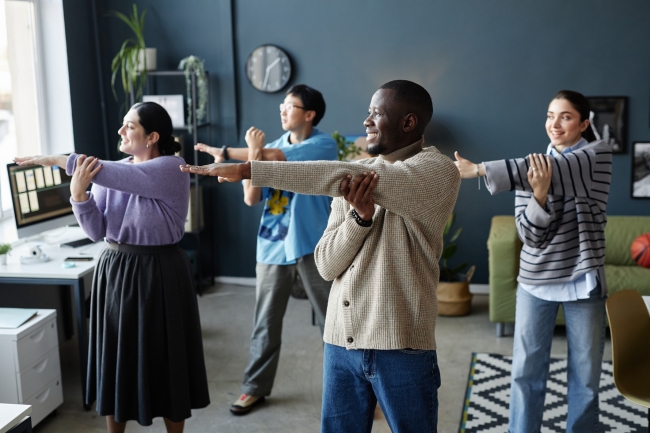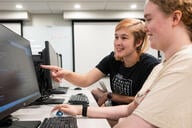You have /5 articles left.
Sign up for a free account or log in.

A short exercise break during class can help students stay motivated to learn and feel more connected to their peers.
SeventyFour/iStock/Getty Images Plus
Physical activity has known benefits for people and their overall health, including brain health, disease prevention and increased life expectancy for many. Exercise breaks also can help student learning by sharpening focus and boosting motivation inside the classroom when incorporated into teaching.
While most faculty members want to boost learning and engagement, incorporating fitness may seem like more of a challenge than a solution. One faculty member from Ohio State University conducted a feasibility study in four of his courses to gauge the practical implications of physical activity in the classroom and how to get student buy-in.
The new research, published April in the Frontiers in Sports and Active Living journal, highlights best practices in physical activity breaks and what students think of the experience.
The background: In classroom settings, previous research studies have focused on how physical brain breaks, in which students spend a few minutes engaging in some form of exercise during class, can decrease off-task behavior and improve test scores among elementary and middle school students.
A 2018 study focused on undergraduate students found that five-minute brain breaks throughout a 50-minute video lecture that involved physical activity had better focus than nonphysical breaks or no breaks at all.
Scott M. Hayes, a psychology professor at Ohio State, wanted to understand what it would look like practically to implement exercise breaks into an in-person higher education classroom setting.
How it works: Hayes incorporated exercise breaks into four of his upper-level psychology in-person courses from spring 2019 to spring 2020 and spring 2023, with a total enrollment of 223 students. Classes took place in large lecture halls as well as active learning classrooms grouped by tables.
At the start of the term, students were assigned to read the 2018 study from the Journal of Applied Research in Memory and Cognition before discussing it in the first class. This helped students understand the rationale behind the activity and gain buy-in because this was an unfamiliar practice to them in a university setting.
Students completed a physical activity readiness questionnaire to confirm safety in their participation, and those who needed exemptions modified or chose alternative exercises as needed.
Students were randomly assigned to groups of varying sizes, depending on course size, with the goal of each group leading an exercise routine for at least once class during the term.
During the second class, each group (between two to seven students) created a team name and developed an exercise routine of five bouts, 50 seconds each, with a 10-second break between each bout, to get students’ heart rates up.
One example of a workout:
- 50 seconds of jumping jacks
- 50 seconds of deep breathing and hand stretches
- 50 seconds of butt kickers
- 50 seconds of side-stance leg stretches
- 50 seconds of high knees
Groups posted the exercise routine to an online discussion group, letting the instructor provide feedback and review the exercises to ensure it was a full body routine that met aerobic requirements.
Each class thereafter, breaks were implemented for each lecture, with the leading group responsible for demonstrating the exercises to the class and timing each phase of the exercise. The exercise breaks happened around the halfway point and soon before the end of the class.
The results: The study achieved its goal in understanding the feasibility of implementing exercise breaks led by students in classrooms of different sizes and formats, and most participants agreed it added to their course experience.
From the four courses’ end-of-term feedback, students reported benefits from the exercise breaks including improved motivation, attention and engagement with peers and instructor. Some students did report not enjoying the breaks, with one saying they dreaded it and another suggesting only one break was necessary per class period.
A spring 2023 survey of course participants (n=27) found similar results, with most describing a positive impact of the exercise breaks regarding their attention and class enjoyment.
During the class, students would also comment on how much they liked the exercise breaks, that they liked the general class participation levels and one commented that it motivated them to exercise more outside of class.
Special features: A 2019 study on student motivation to engage in physical activity breaks found enjoyment and needing a break were the top motivators for participation among students wanting to contribute to research.
Some of the elements of this study that may have boosted student participation and enjoyment include:
- Relationship building work. Each group had a team name and had to introduce themselves when leading exercises in the class, helping foster a sense of connection among peers and encouraging participation.
- Faculty involvement. The instructor participated in each of the exercise bouts, sometimes intentionally deviating from the demoed activity to remind students that they could modify their workout if needed.
- Incentives. Students earned points for designing an exercise routine, serving as group leaders and for participating in exercise breaks led by other students.
- Student choice. Each group got to elect which exercises they did, how they delivered the experience and even if they wanted to play music during the exercise break, which may have contributed to student buy-in and enjoyment of the practice.
Tell us about an initiative on your campus to help improve students’ physical health. Share here.




